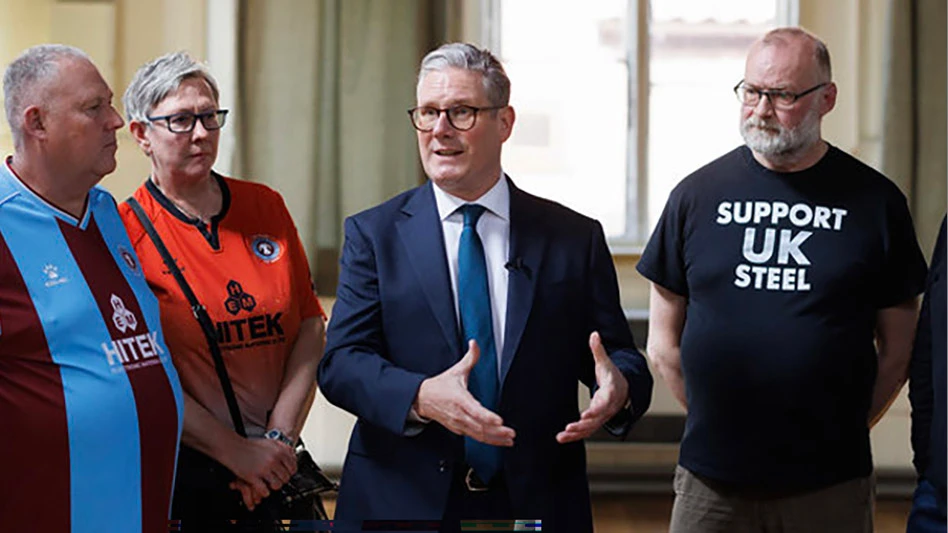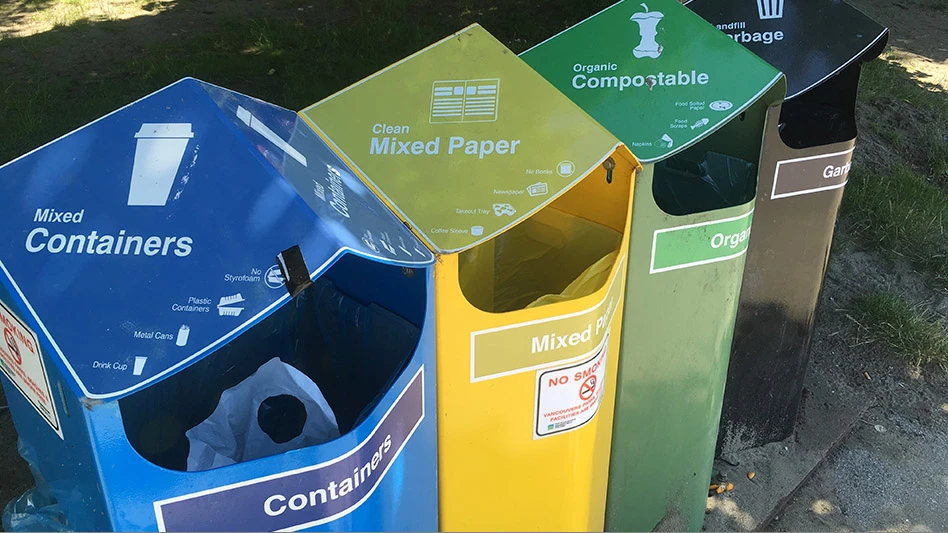They say good things come in small packages. With the recent boom in mini-mills, that certainly has been true for steel recyclers. Even the term "mini-mill" is probably obsolete. The packages are not necessarily small any more. Electric-arc furnaces (EAFs) are being used in operations which cannot be termed "mini" by any stretch of the imagination.
It seems there is hardly a bend on the Mississippi or any of its major tributaries that is not home to an electric-arc furnace carbon steel producer, or at least the site of a planned mill. What is shocking to many, however, is the unusual locations—Nebraska, Arizona, South Carolina, Utah—where steel mills are popping up and thriving. While the surge in the number of buyers locating in non-traditional areas is good news for recyclers, many industry analysts are predicting a wave of integration at the mills in the next couple of years.
Despite the recent drop in demand for steel, caused by the Asian crisis and exacerbated by the problems in Russia, U.S. markets for steel scrap are still relatively strong, pushed by domestic production. Currently in the 105-110 million tons per year range, it is expected to increase by four to six million tons by the Year 2000.
Much of that demand for steel will be met by the booming mini-mill industry. EAFs are expected to ship 14 million tons of hot rolled bands and related products in the Year 2000. Contrast that with three million tons shipped in 1995. Back in 1981, EAF production represented 15% of U.S. steel production. By 1991, that figure had risen to 22.7%. Today, nearly half of the steel making capacity in the United States is EAF-based.
This EAF business is not the steel industry our fathers grew up with. It is quite separate from the traditional integrated steel industry, so much so that the mini-mill members of the American Iron and Steel Institute broke away from the parent group in 1988 and formed their own trade association: the Steel Manufacturers Association (SMA), Washington.
While the integrated and mini-mill industries have some common ground, they differ on many fundamental issues, including environmental policy. The mini-mill people tend to be more free-trade oriented and open to international competition. The lion’s share of the mini-mills are not union shops, so there are differences in the way the two segments of the industry approach labor issues.
One constant effects both, however. That is supply and demand.
Supply-Demand
"The supply-demand picture has changed in the last three to six months because of the Asian situation. But the short-term market does not affect long-term strategy," says William Heenan, president of the Steel Recycling Institute, Pittsburgh. "It seems that every three to five months we hear a new announcement for a mill and I haven’t heard anyone backing off on their plans to do what they said they would do."
While noting that less scrap is going out of the country, he notes the weak yen means more scrap available to the domestic industry. "Scrap is still moving. The price has been dropping from historic highs," he admits, "but despite the softening it still is at a darned high level."
Not everyone is so sure that the bull will run for much longer. Philip Tomlinson, director of steel for CRU International Ltd., London told attendees at last fall’s "Mini-mills of the Future" conference (sponsored by Midrex Direct Reduction Corp., Charlotte, N.C.) that he sees signs the market for steel sheet is at its peak. He added that the impact of nearly two million tons of new capacity brought on-line in 1997 and more than five million tons in 1998 depends on the prospects for both demand and trade.
Jerry Goodwald, director of operations for North Star Steel, Minneapolis, Minn. would agree. "Scrap dealers are in for some tough times ahead," he warns. While North Star is more interested in beating the competition based on its conversion costs, not hedging scrap, Goodwald says he does not see mills carrying a lot of scrap inventory in the near future.
Tomlinson says he expects overall sheet demand to fall, although coated sheet is expected to be stronger than other products.
Because of the Asian crisis, demand for shredded, #1 heavy melting and most other categories has dropped. Prices have dipped for three consecutive months. The #1 heavy melting is off 50 percent since the crisis started, and other grades have dropped 30% to 50%.
Look at the steel industry from the point of view of a Korean or Japanese manufacturer. In less than a year, the Japanese Yen has gone from 120-125 per dollar to 145-147 in early September. That is a 20% drop in the Yen’s value. Translated, the steel with a $400 price tag in December 1997 is worth only $320 today.
Since the manufacturers in Japan are not purchasing steel at all, the Japanese mill looks off-shore for a country that still is consuming steel. Today, that is the United States. The Japanese mill is going to be quite competitive with the U.S. domestic market. The result is an abundance of alternative iron. Suddenly, a new U.S. mill, with its $20-$30 margin on tonnage is not as attractive as it was when the accountants and engineers were designing it. "People are going to reconsider plans," says Goodwald.
While none of the former Soviet states really is a major factor in either steel consumption or scrap production, the ruble crisis and the overhanging feeling of economic emergency has done nothing to help boost consumption in other quarters of the globe.
The bottom line: there is a tremendous amount of flat rolled capacity. North Star has opened its Delta, Ohio plant. TriCo, SDI, Nucor and others have brought capacity on-line. At one time, flat rolled capacity was projected at 20 million tons—however, some of the planned expansion has gone by the wayside. But even there, scrap dealers got crunched. What looked like a situation apt to produce a shortage of steel just six months ago has turned into a market glut. On top of that, some mills, anticipating the same shortage, bought supplies of scrap for future delivery or stockpiled extra scrap when they could get it. Now, with exports of scrap falling off badly, and domestic consumption lagging, scrap prices are dropping fast.
"Those fundamentals will take some time to correct," Goodwald says. He sees no real change over the next 60 days, at least.
Beyond Pricing
Even if one accepts the argument that prices are a short-term consideration, there are other things to ponder. The industry must deal with two problems: the relative impurity of their products compared with integrated-mill steel and the lack of finishing capacity, William T. Hogan, director of the Industrial Economics Research Institute at Fordham University, New York told the Mini-mill conference. He sees several solutions, all requiring further investment.
Addressing the purity problem, Hogan cited Pohang Iron & Steel Co. Ltd. in South Korea, which is building a fifth blast furnace to produce three million metric tons of iron to feed a new electric-furnace mill with thin-slab casters and a rolling mill. "But this strategy of building a $200-million to $300-million blast furnace to provide the basic material for the electric furnace won’t catch on" because of the huge cost, he said.
U.S. and overseas electric-arc furnace steelmakers instead are investing in direct-reduced iron facilities. "This makes a mini-mill an integrated producer because they’re making their own raw materials," he points out. To solve the second problem—lack of finishing
Capacity—he predicts greater investment in downstream operations. "Hot bands are not very profitable, and mini-mills are missing out on the opportunity to make a higher profit on finished product," Hogan told the conference. He cited the significant profits earned by many processors, such as Huntco Inc., Worthington Industries Inc., Steel Technologies Inc. and Olympic Steel Corp., which cold reduce and galvanize hot bands.
"It seems inevitable that mini-mills and processors will engage in mergers, joint ventures and acquisitions. There is no chance for mini-mills to survive and profit without acquiring their own iron-making and steel-finishing facilities," Hogan stated.
There seems little doubt that mini-mills will become more integrated as they acquire or partner with upstream and downstream operations. Robert A. Garvey, chairman and CEO of Birmingham Steel Corp., Birmingham, Ala. said that although integrated producers have the perceived edge on customer service and research and development, equipment manufacturers conduct the research and development while the mills merely buy the equipment and put the ideas into practice.
"If there’s been a failure among mini-mills, it’s that there’s a gap of talent," he said, meaning the younger companies are short on engineering and design experience. He said he believes that gap will close, and then "integrateds will eventually make more money selling pig iron to (mini-mill) competitors than in making hot band," he said.
"There will be continued rationalization among integrateds. Only three will remain in ten years—it is those who are investing capital in their facilities now who will survive down the road," Garvey said. He added that only six or seven mini-mill companies will serve the vast majority of steel consumers in ten years.
Mini-mills choose not to get complex in their applications, he said, but in order to compete effectively in the future they will have to address customer service and research and development when they acquire the talent and experience to do so. Garvey predicts that "Birmingham will control 50% of its raw material requirements; that’s integrated."
The term mini-mill has lost much of its relevance as a meaningful definition for a sector of the steel industry, maintains Scott Morrison, research analyst with Morgan Stanley & Co., New York City. In considering the outlook and growth prospects for electric furnace-based steel makers, Morrison divides the players into two tiers. One tier will continue to focus on traditional products and in most ways, except for size, will continue to resemble the mini-mills as we know them.
"For these producers, growth will come only from cost cutting, adding low-cost incremental capacity, and consolidation, a situation I believe will result in larger and more efficient producers but fewer of them," Morrison told the conference. "For this group, growth is a zero sum game. They reached the point of saturation and now every ton of incremental capacity added puts pressure on an existing ton of capacity to shut down," Morrison told the Mini-Mill conference.
The second tier of electric furnace producers might be integrated upstream. They produce high-quality bar and rod, plate and sheet using highly capital intensive production processes. "They have a favorable competitive landscape and, as technology further reduces the barriers to entry, we will see more of these steel makers that will be high-growth companies with superior profitability," Morrison said. "For this segment, growth is not a zero sum proposition."
This second tier of mini-mills already exists. When Chaparral Steel Co., Nucor-Yamato Steel Co. and Northwestern Steel & Wire Co., for example, began producing medium and heavy structural products, they drove out imports and most of their integrated competitors. This newer group of steel makers includes partnerships between mini-mills and integrated mills such as Co-Steel and Dofasco’s Gallatin Steel and BHP and North Star’s Delta, Ohio, mill, Morrison said.
He also cited LTV Corp., British Steel Plc and Sumitomo Corp., who created the Trico joint venture in Decatur, Ala.; and Steel Dynamics Inc. and Qualitech Steel Corp., "which represent interesting partnerships between entrepreneurial managements, financial investors and strategic partners that supply raw materials and buy the production."
The electric-art industry represents 42% to 44% of the furnaces in this country. Morrison said there will be three main effects on the industry as it evolves. "The first is that these new players have the potential to earn excellent returns with new product ranges. Their cost structures should be superior to many of the current suppliers," the analyst said. Of course, the hope of great returns will encourage more entrants into steel making.
"The second effect will be higher scrap prices, $20 to $40 higher," Morrison estimated. "Although scrap substitutes will eventually be a viable alternative, there is going to be a lag between the start-up of the mini-mills and the start-up of scrap substitute projects."
The scrap alternatives will be used as part of the furnace charge, but not enough to offset all the increased demand for steel scrap. "The third effect will be margin pressure on the competitors of the new mini-mills as a huge amount of new, low-cost capacity in special bar quality, plate and sheet comes on-line over the next few years. Net imports will be reduced," Morrison said, adding, "I look for some integrated capacity to close."
The movement of the steel industry from the traditional belt across the Great Lakes from Gary to Pittsburgh to the West, Rocky Mountains and the Deep South would seem to indicate that overall demand for scrap will boom in some areas and bust in others. Closings or consolidations could spell disaster for a given geographic area, while the establishment of new mills in non-traditional locations like Arizona and Virginia will mean local prosperity.
North Star’s Goodwald notes that U.S. domestic steel consumption has surpassed supply over the past few years. Imports made up the difference. He says that, with U.S. steel makers back to world-class status, from a technology and cost point of view, that the U.S. mills will do a better job than overseas producers—given a level playing field. They certainly will have the scrap to fire the mills with.
"There is no way that even a Trico can consume all the scrap available in California," Heenan says. He maintains that factors like tax benefits, available labor and electricity rates will continue to be the basis for steel executives’ decisions on where to locate new electric-arc furnace operations. "Of course, availability of scrap will continue to be a key factor," he says.
In five years, industry observers may look back and chuckle about the optimistic projections made for the EAF industry in the late 1990s. It is doubtful, however, that they will be able to dismiss the estimates completely. Already, the EAF business has grown beyond what anyone would have guessed coming into the decade. Should world markets settle sooner than some observers figure they will, steel consumption and the market for scrap will bounce. Then, even the more optimistic of those projections may look positively prophetic.
The author is an environmental writer and Recycling Today contributing editor based in Strongsville, Ohio.

Explore the October 1998 Issue
Check out more from this issue and find your next story to read.
Latest from Recycling Today
- Massive Chinese steelmaking rebound recorded in March
- LME looks into sustainable metal pricing
- OnePlanet Solar Recycling closes $7M seed financing round
- AMCS launches AMCS Platform Spring 2025 update
- Cyclic Materials to build rare earth recycling facility in Mesa, Arizona
- Ecobat’s Seculene product earns recognition for flame-retardant properties
- IWS’ newest MRF is part of its broader strategy to modernize waste management infrastructure
- PCA reports profitable Q1





